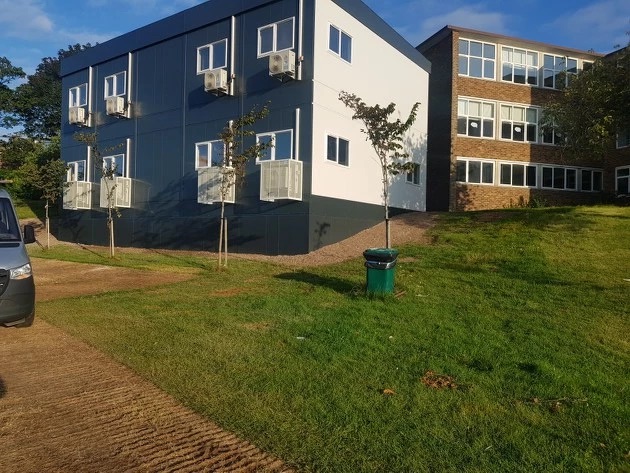Apr23

The significance of a well-designed physical environment in shaping the educational experience cannot be overstated. Within educational infrastructure, modular classrooms have risen as a game-changing solution, offering a blend of innovation and adaptability. This article delves into how modular learning spaces are transforming education, fostering an enriching environment that positively influences students' academic paths.
Introducing Modular Learning Spaces
Crafted in controlled environments before being assembled on-site, modular classrooms provide a modern, adaptable solution tailored to the evolving needs of educational entities, from elementary schools to higher education institutions.
Rapid Assembly with Minimal Interruption
A notable benefit of modular learning spaces is their quick assembly. Unlike the prolonged and disruptive construction process of traditional classrooms, modular setups significantly cut down on construction time and reduce the disturbance to school life, allowing the academic schedule to proceed with minimal interruptions.
Customisation Meets Educational Diversity
Modular learning spaces shine in their ability to be customised to suit a variety of educational objectives and instructional styles. Whether it's a standard classroom, a science lab, or a library, modular structures can be precisely tailored to foster an optimal learning environment. Their inherent flexibility also means schools can easily modify or expand these spaces to meet future needs.
Elevating the Learning Experience
Ample Natural Lighting and Enhanced Air Quality
With designs that typically include large windows and efficient ventilation, modular classrooms ensure that students benefit from natural light and clean air. These elements boost concentration, mood, and health, significantly enriching the learning experience.
Equipped for the Future
Modular classrooms are at the forefront of offering a contemporary setting equipped to incorporate the latest educational technologies. Facilities can be designed with smart boards, high-speed internet, and other digital tools, catering to the demands of today's academic landscape.
Sustainability and Efficiency
Built with green principles in mind, modular classrooms use eco-friendly materials and are designed for energy efficiency, reflecting the increasing focus on environmental stewardship in education.
A Cost-efficient Approach
Educational institutions with tight budgets find modular classrooms an economically viable option. The lower initial construction costs and energy savings from these efficient structures offer substantial financial benefits.
Adaptability to Educational Evolution
The flexible nature of modular classrooms perfectly positions them to adapt to shifts in educational trends and teaching methodologies. From supporting collaborative learning to facilitating project-based instruction, these spaces are easily adjustable to align with innovative educational practices.
Solving Space Limitations
Space is often scarce for educational institutions, especially in urban settings. Modular classrooms present a strategic solution, enabling schools to expand their physical footprint without extensive land use.
Addressing Growing Enrollment Challenges
For areas experiencing population surges or fluctuating student numbers, modular classrooms provide a quick and effective means to accommodate the growing demand for educational spaces, ensuring accessibility to quality learning environments as needed.
Ensuring Safety and Longevity
In the educational sector, safety cannot be compromised. Modular classrooms are built to adhere to stringent safety regulations and are as durable as traditional constructions, offering a secure and lasting learning environment.
Embracing Inclusivity
Modular classrooms are designed with inclusivity in mind to ensure accessibility for all students, incorporating features like ramps and adaptable furnishings to accommodate diverse needs.
Real-World Impact
Globally, modular classrooms have proven their efficacy in enhancing educational outcomes, from facilitating rapid deployment in disaster-stricken regions to enabling space expansion in densely populated schools.
Looking Ahead
As educational needs continue to evolve, modular learning spaces stand ready to meet these challenges with innovative design and technology. They represent a forward-thinking approach to educational infrastructure, promising to adapt to the changing landscape of learning continually.
Educational institutions can significantly improve the quality of the learning experience by opting for modular classrooms, embracing a solution that is flexible, sustainable, and conducive to educational advancement. Explore the potential of modular learning spaces with Phoenix Building Systems and take the first step towards transforming your educational environment.
By Thomas Lore
Keywords: Education
 The Board Chair as the Primary Lever of Psychological Safety
The Board Chair as the Primary Lever of Psychological Safety Friday’s Change Reflection Quote - Leadership of Change - Change Leaders Maintain Trust and Legitimacy
Friday’s Change Reflection Quote - Leadership of Change - Change Leaders Maintain Trust and Legitimacy The Corix Partners Friday Reading List - January 16, 2026
The Corix Partners Friday Reading List - January 16, 2026 Effective Government Is Built: A Five-Pillar Framework for Public Leaders
Effective Government Is Built: A Five-Pillar Framework for Public Leaders Tariffs, Data, and the Complexity of Compliance
Tariffs, Data, and the Complexity of Compliance